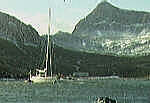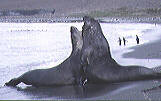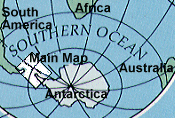
![]()
.
.
.
.
.
.
.
.
.
.
.
.
.
.
.
.
.

.
.
.
.
.
.
.
.
.
.
.
.
.
.
.

![]()

[
Logbook Index ]

Log
Entry for 3 February 1997
Position: 54-17S 36-30W.
Click map
for detailed chart
Still moored to the jetty at Grytviken.
Wind NE 35 knots snowing all day.
Update on plans and account of
adventures leaving Cooper Bay for Grytviken.
|
With the boat journey 'gone by the board,' the South-Aris team's thoughts are now centered on completing the mountain traverse from King Haakon Bay on the southwest coast to Stromness on the northeast side ( see map ). Therefore our goal was to get north as soon as possible, check in with the authorities at Grytviken, then move around to King Haakon Bay. At least that was the plan on January 29th in Coopers Bay, on that beautiful sunny day that Elena described in the previous story. As usual, when the weather is good in South Georgia it is really good and optimism runs high. Frank Nugent set a schedule that had us in King Haakon in four days time. Well, the real South Georgia laid waste to those plans in a jiffy. That night the big low Bob Rice had been predicting - the one we were racing to shelter from in S Georgia - struck with a vengeance. Within hours we had an horrendous swell inside what we thought was a secure anchorage. Although the cove was protected by barrier rocks, the deep low pressure, coupled with a swell coming in from the east, caused an inordinately high tide turning our sanctuary into a bit of a maelstrom! All night, our keel, fully down, gently touched the rocks on the bottom reverberating through the steel hull like a bass drum - disconcerting for some of the crew! At 0400 on the 30th, the wind had suddenly filled in from the east and we were now drifting further into the bay towards the beach. Patrick, Jamie, Elena and I got dressed and rearranged the shore warps to rocks to keep our bow upwind and facing into the swell - a two hour job that had earned us our breakfast. It was now blowing snow from the northeast and very dull weather. As I explained to the Irish team, "we have arrived on South Georgia, now we can sit tight and wait this out. There are no options." On this island, expeditions typically achieve very little, even given ample time, because the island lies directly in the path of major depressions which funnel through the Drake Passage. This, combined with the high mountainous terrain - two major ranges over 7000 feet straight from the sea - cause the weather to be routinely turbulent. It is characterized by high katabatic winds gusting to over 100 knots from any direction and long periods of low visibility. Patience, a lot of good rope to keep the boat secure and plenty of good books to keep your mind right, are all necessities for sailing here. Throughout the day of the 30th, the wind increased and it snowed on and off. Because the wind came from offshore we had very few 'williwaws but the swell increased. We had to lift the keel one third, which decreases our draft by a meter, to avoid slamming on the rocky bottom. Lifting the keel has its disadvantages in these conditions as the loss of stability causes the boat to roll and pitch even more. It was like being at sea all over again! The sea breaking over the barrier rocks protecting our anchorage was dramatic. Our port side bow line - 170 meters of floating 22mm rope - anchored to a big rock gendarme topped with tussock grass was continually lost behind walls of water. There would be no checking the line over there! That night it really snowed and we woke up to 10 cms on deck at 0400 when the bow line parted because of chafing on the rocks. The low had bottomed out at 962 mb and the wind then swung into the south. So it was back in the dinghy, more lines out and a resetting of the main anchor. Patrick and Jamie were the 'dinghy team' while Elena and I worked the lines from Pelagic; spooling off more rope, joining lengths and then winching in, all the time sliding around in the slushy wet snow. Patrick wore his Musto survival suit and had to swim across a channel to clear one of the lines. Extreme conditons you say? No, this is South Georgia! That day we took another walk to see the elephant seal bulls sparring in the big surf. The coast was awash with white water, a big pipe continually crashed onto the black beach and the air was filled with flying spray. The penguins and seals just seem to love rough seas. Well, I have to admit, so do I! Wild, natural beauty in its most savage form, especially during storms at sea and in the mountains, although sometimes a misery, always gives me a simple feeling, a message that says, "yeah man, your're alive!" We could have stayed in Coopers Bay for days waiting for ideal conditions to leave - but we had a schedule to keep and the South-Aris team were getting anxious to be on their way. Coopers Bay, once our refuge had now become a trap of sorts. The next morning (after a full nights sleep!) the swell was still running in the channel, but I judged it was worth risking to escape. It took two hours of graft to retrieve all the shore lines, spool them up and lift the anchor. I had to raise the keel almost to the maximum, decreasing our draft to 1.5 meters - a dodgy exercise in a swell, but even more so here, as a 'williwaw' from the wrong direction could lay us flat to the water. It was touch and go through the entrance - we grounded three times, had to retreat once and start again. It took a few more hard bangs and lurches, and some long faces, before we broke free into 3 meters of water. Down keel, pin it, and outa here! We were on our way north to Grytviken in a fresh southerly. Jamie said to me, "well, you have certainly convinced us of the merits of the lifting keel!". Skip Novak |


